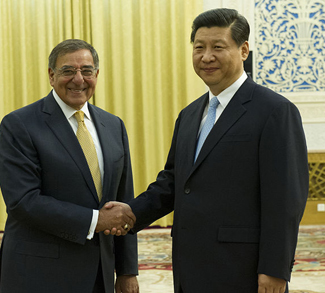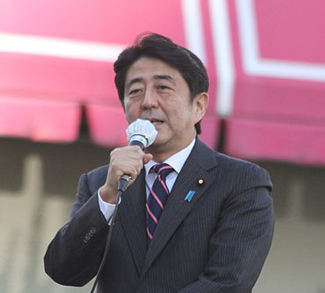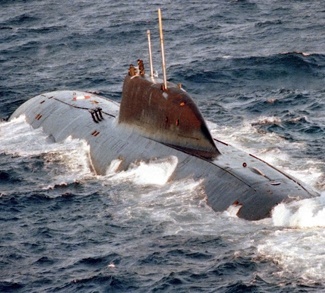Enrique Peña Nieto, the candidate of the Institutional Revolutionary Party (PRI), is likely to become Mexico’s next president following the July election. A capture of Joaquín ‘El Chapo’ Guzmán Loera, however, chief of the Sinaloa drug cartel, could provide a significant impetus for Felipe Calderón’s center-right National Action Party.
Just as Americans were watching the Giants nose out the Patriots in Super Bowl XLVI, President Felipe Calderón has his eyes fixed on a much most important showdown in Mexico—the July 1 presidential contest. He and his center-right National Action Party (PAN) have scored back-to-back triumphs (2000 and 2006) in this sexennial free-for-all. Yet the odds are so long against them this year that the chief executive is contemplating a political version of the Hail Mary pass to give momentum to his party’s candidate and, if victory remains a longshot, at least prevent a humiliating third-place finish.
What has thrust Enrique Peña Nieto, standard-bearer of the once-hegemonic Institutional Revolutionary Party (PRI) into a commanding lead? Does the Left, whose nominee is Mexico City’s messianic former mayor Andrés Manuel López Obrador (AMLO) have a chance for an upset? Might the capture of Joaquín “El Chapo” Guzmán Loera provide the “game changer” for the PAN and turn a likely shellacking into a competitive race?
PRI’S Momentum
The 45-year-old Peña Nieto benefits from a medley of assets: he is movie-star handsome; married to a gorgeous television celebrity; captured the PRI’s nomination without a challenge; boasts a war chest groaning with resources; has lavished tens millions of dollars to promote his candidacy on media conglomerates Televisa and TV Azteca; and enjoys the backing of two small shadowy parties (The Mexican Ecological Greens—PVEM; and the teacher-union dominated National Alliance—PANAL).
Despite several gaffes on the hustings—he could not name two books other than the Bible that had influenced his life, and he confused distinguished Mexican authors Enrique Krauze and Carlos Fuentes—Peña Nieto enjoys 42-44 percent backing in a three-way contest, according to the latest Mitofsky poll. This places him well ahead of AMLO (17-19 percent), as well as the PAN’s aspirants, Josefina Vázquez Mota, 51 (21 percent), chosen on February 5 in a three-way race among Sen. Santiago Creel and Calderón’s favorite ex-Finance Secretary Ernesto Cordero Arroyo.
The Left’s López Obrador is a loose cannon on the deck. After suffering an eye-lash thin defeat six years ago, he claimed “fraud” over Calderón’s investiture and declared himself the nation’s “Legitimate President.” He proceeded to stage his own inauguration, named twelve-member cabinet, pillory the administration’s ventures, and frenetically barnstorm the country several times. His platform—protectionism, a robust welfare state, and massive government intervention in the economy—evokes memories of the traditional PRI in which he began his political career three decades ago. It’s more likely that a glacier will engulf the Sonoran Desert than the quixotic AMLO’s becoming the nation’s next número uno.
Problems Beset Calderón’s PAN
The PAN suffers from Calderón’s uninspiring leadership, the roadblocks to his legislation thrown up by opposition parties, anemic growth, and the 39,120 drug-related deaths that have taken place since he swore the presidential oath on December 1, 2006. In addition, a nasty donnybrook over the nomination for their party’s candidacy casts another dark cloud over their prospects; a stalemate afflicts relations between the executive and legislative branches; and the national stalemate has enhanced the power and impunity of the 31 governors and Mexico City mayor, who have become their nation’s new viceroys.
Yet, only the PAN stands an outside chance of preventing “golden boy” Peña Nieto from obtaining the keys to Los Pinos presidential residence, which the PRI held for 71 years.
Game Changer?
One possibility would be a no-holds-barred assault on Los Zetas, a northern-based cartel of roughly 700 to 1,000 cadres that sprang to life as the Praetorian Guard for the Gulf Cartel, with which it is now engaged in a vicious war. Founded by Mexican Special Forces and spearheaded by Heriberto “The Executioner” Lazcano and Miguel Angel “El 40” Treviño Morales, Los Zetas thrive on barbaric acts that ensure them a place in Hell’s lower echelons. They boil babies alive, torture and decapitate foes, castrate enemies whom they burn to a crisp, and sledgehammer the heads of uncooperative Central American migrants whom they hurl into mass graves.
In addition to drug trafficking, Los Zetas have branched into extortion, kidnapping, murder-for-hire, small-time drug selling, oil theft, contraband, human smuggling, loan sharking, arson, the sale of body parts, prostitution, and a dozen other criminal pursuits. These sadists also invest in casinos, hotels, restaurants, resorts, pharmacies, and other “legal” ventures.
While arresting or killing “The Executioner” or “El 40” would constitute a body blow to organized crime, these fiends have rings of bodyguards and do not have the international pizazz of Guzmán Loera, capo of the Sinaloa Cartel whom Forbes has ranked as one of the “World’s Most Powerful People”: 41st (2009); 60th (2010); and 55th (2011). The magazine, which identifies him as “the biggest drug lord of all time,” also listed him as the 10th richest man in Mexico.
The U.S. ($5 million) and Mexico ($2.3 million) have hefty bounties on his head.
El Chapo—a nickname for “Shorty”—made a derring-do escape secreted in a laundry cart from the Puente Grande high-security prison soon after the PAN first garnered the presidency in 2000. His Sinaloa Cartel has a solid command structure that includes Ismael “El Mayo” Zambada García, Manuel Torres Féliz, and Juan José “El Azul” Esparagoza.
El Chapo and his comrades have shown enormous ingenuity in smuggling drugs into the US. They have stuffed beer cases, shoes, dolls, and surfboards with their merchandise. A women captured in Tijuana had a protruding belly, caused not by pregnancy but by a packet holding several pounds of tightly wrapped cocaine. Another female, who carried cocaine that had been surgically implanted in her buttocks, died of blood poisoning when a container burst upon her arrival at the Mexico City airport.
The Sinaloans operate throughout the Americas, Europe, and Asia, specializing in trafficking billions of dollars’ worth of cocaine, heroin, marijuana, and methamphetamines.
Unlike the barbarous Zetas, El Chapo presents himself as a Godfather type, who promotes charitable works, seeks to protect the Sinaloa-Durango-Chihuahua “Golden Triangle” from other criminal syndicates, and generates employment in his home region. “The Sinaloa Cartel is to local residents as Boeing is to Seattle,” stated one astute observer.
Pundits insist that peasants in his municipality of Badiraguato wear no clothing, except for a hat, which they doff when the 54-year-old kingpin rides by.
On several occasions, El Chapo—or “El Tío”/”The Uncle,” as he prefers to be called—has entered posh restaurants such as “Barrokas” in Piedras Negras, Coahuila. Once his protectors had looked the eatery’s doors and collected cell phones, the capo glad-handed the up-scale patrons as if he were a Chicago assemblyman before entering a backroom to feast on expensive cuts of beef and fist-sized shrimp. Two hours later, he slipped out a back door, and the incredulous dinners found that their tabs had been covered.
Some law-enforcement professionals believe that the once “untouchable” El Chapo may be more vulnerable than ever. Los Zetas—in league with the Sinaloa-based Beltrán Leyva Organization—have made inroads into the Sinaloan municipalities of Gusave, Mazatlán, and Concordia, as well as into Guadalajara, Jalisco, formerly a bastion of Guzmán Loera’s operations.
Rumors abound that El Chapo tipped the army to the whereabouts of several of his erstwhile comrades—possibly because he regarded them as a threat; possibly because of his incipient paranoia; or possibly because he sought to eliminate those familiar with his current activities and whereabouts.
On July 29, 2010, soldiers killed Ignacio “El Nacho” Coronel Villarreal, a pioneer in meth processing, in his posh mansion in Zapopan, Jalisco; and in early October, the army arrested Noel “El Flaco” Salgueiro Nevárez, allegedly a top lieutenant of the Sinaloa cartel and founder of its ” Gente Nueva” or “New Men” squad of gunmen. The soldiers accomplished the take-down in Culiacán, Sinaloa’s sprawling capital, without firing a shot.
On December 23, 2011, they arrested Felipe “El Inge” Cabrera Sarabía, believed to be boss of the Sinaloan’s security unit in violence-torn Durango state, and five weeks later, the Federal Police apprehended Gente Nueva boss and feared killer José Antonio Torres Marrufo in Guanajuato.
In a body blow to the Sinaloa Cartel, the Federal Police announced the incarceration of Jaime Herrera Herrera on Valentine’s Day. The “old man,” as he was called, processed and distributed methamphetamine for the outlaws.
Conclusion
Apart from brightening the PAN’s dim presidential outlook, the capture of El Chapo would spike scuttlebutt that Calderón’s regime has either cut a deal with or ignored the Sinaloan strongman in favor of pursuing more vulnerable criminal organizations. On April 18, 2009, Metropolitan Archbishop Héctor González Martínez claimed the diminutive fugitive was “living nearby and everyone knows it except the authorities, who just don’t happen to see him for some reason.”
An arrest would also help mitigate the embarrassing allegation that Guzmán Loera visited his wife, a U.S. citizen, after she gave birth to twins in a northern Los Angeles County hospital last September. In the words of Edgardo Buscaglia, a senior scholar at Columbia University, the “capture of Chapo would represent huge political capital” for the president and his party.
In light of the intramural disputes and disarray besetting the PAN and the Left, the reappearance of the Virgin of Guadalupe might not be sufficient to thwart a PRI victory in five months. Still, bringing down El Chapo would alter Calderón’s place in his nation’s score books from a chief executive who waged a bloody, unfocused drug war to a leader who eliminated a criminal compared favorably with Osama bin Laden, Butch Cassidy, and Al Capone. It could also reduce the river of drugs cascading between Sonora and Arizona–90 percent of which the Sinaloans control, as reported by the U.S. Department of Justice.



